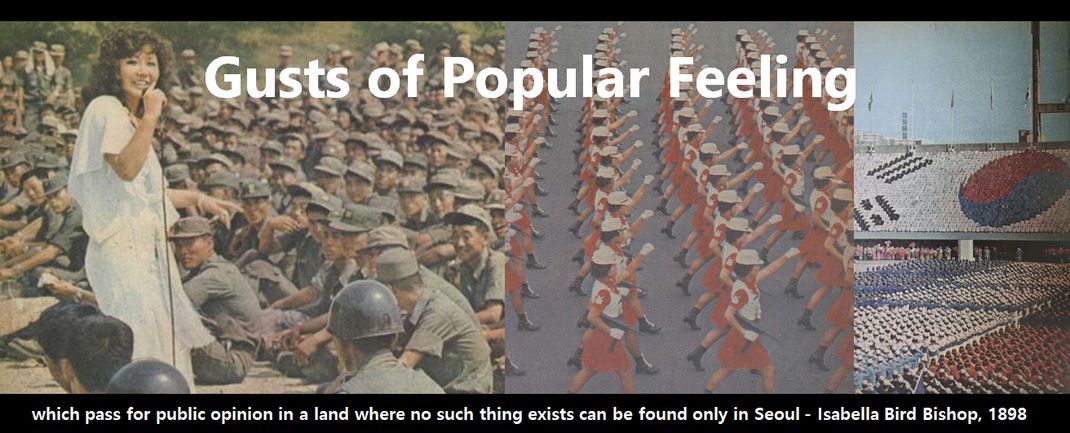the government started building primary schools in the capital, main ports, and main provincial centers. By 1900 it was using 163,005 won - approximately 3% of its annual budget - to support nine public primary schools in the capital and around 40 schools in the provinces, each teaching around 20-50 schoolboys.As I noted in this post, Yangcheon Elementary School opened in 1900 as the Gongnip Sohakgyo, or public elementary school, which would suggest that Yangcheon was considered a reasonably important area at the time (and its Hyanggyo, or Confucian shrine, is the only existing one in Seoul today).
I decided to search through The Independent, the English version of the Dongnip Sinmun published from 1896 to 1899, for mentions of the area. You can search the paper by going to www.kinds.or.kr (using IE), clicking on 고신문 followed by the 검색서비스 button on the left. The 독립신문_영문판 is The Independent, and any English language (or Roman alphabet) search you do there will only give results for 독립신문_영문판, which you can click on to get the results.
A search for Yangchon turns up an article about a census of Gyeonggi-do on page three of the May 25, 1897 edition of The Independent under the heading of [Government] Departmental News:
The following is the census of twenty-nine out of thirty-eight districts in Kyengki Province:ㅡIt's interesting to see that Yangju was the most populated area in Gyeonggi at the time, and that Yangcheon had only 1,040 houses and a population of 4,656. As can be seen from this map of Yangcheon Hyeon (county) from 1875, it encompassed what is today Gangseo-gu in Seoul, the population of which is 546,938, meaning it has grown over 100 times since 1897.
District. House. Male. Female. Total Population.
Inchon. 6,293. 14,768. 11,863. 26,621.
Yangju. 16,754. 36,693. 30,282. 66,975.
Changtan. 5,966. 11,756. 9,342. 21,098.
Tongchin. 2,719. 6,246. 5,331. 11,577.
Paju. 2,719. 8,892. 7,512. 16,334.
Richon. 2,777. 6,175. 4,988. 11.163.
Bupyeng. 2,021. 6,395. 4,988. 11.573.
Namyang. 5,177. 10,933. 8,728. 29,661.
Pungduk. 4,168. 9,151. 7,806. 16,957.
Pochon. 5,207. 9,012. 7,184 16,195.
Jukean. 4,030. 8,569. 7,470 16,039.
Yangkeun. 4,203. 7,866. 6,393. 14,259.
Sakyung 23,49. 4,463. 3,638. 8,091.
Ansung. 2,903. 5,643. 4,433. 10,076.
Koyang. 4,676. 10,536. 8,630. 19,266.
Kimpo. 1,751. 3,673. 2,877. 6,550.
Yungpeng. 3,555. 7,890. 6,357. 14,353.
Majon. 1,388. 2,946. 2,611. 5,557.
Kioha. 2,615. 5,699. 4,730. 10,429.
Ryongju. 4,875. 10,534. 8,491. 19,025.
Eumjuk. 1,750. 4,007. 3,204. 7,211.
Chinwi. 2,228. 5,000. 3,767. 8,767.
Yangchon. 1,040. 2,580. 2,076. 4,656.
Siheung. 2,102. 3,769. 2,911. 6,680.
Chipeng. 4,003. 8,795. 7,057. 15,852.
Juksung. 2,085. 4,561. 3,329. 8,890.
Yunchon. 1,524. 2,068. 2,452. 5,420.
Yangsung. 2,153. 4,572. 3,475. 8,047.
Kiodong. 1,316. 2,990. 2,434. 5,424
Grand total: Number of houses, 105,048; population 412,247. (The returns from the remaining nine districts have not yet been received by the Home Department.

Another article about Yangchon appears on page two of the February 19, 1898 edition of The Independent under the heading of [Government] Departmental News:
About ten days ago three travellers stopped over night at an inn in Yangchon district. After midnight one of the guests packed up the personal effects of his comrades and made his way to a neighboring village. The inn keeper heard a noise in the guest chamber and went out in the yard to investigate the cause of the untimely commotion. He caught a glimpse of the departing thief and immediately aroused the other guests and gave chase. The thief was overtaken at an inn two miles distant. He had donned the garb of a Confucian disciple and was sitting with the bar-maid exchanging with her sweet sentiments. The pursuers pounced upon him and bound him. A messenger was dispatched to the magistrate of the district asking him to take charge of the thief. The latter sent a squad of police and lodged him in jail. The Confucian disciples of the district became very indignant over the action of the magistrate for treating their fellow-scholar with such unceremonious procedure and they threatened to break the jail and set the prisoner free. The magistrate requested the governor of the province to send police [re]inforcements to protect the jail.I'd guess that the "Confucian disciples of the district" were connected with the aforementioned Confucian shrine (which I looked at here). One wonders where on this map the inn where the thief was exchanging "sweet sentiments" with the bar maid...


2 comments:
I'm more intrigued by the large gender imbalance in the survey
I was so fixated on the households/total population I didn't even notice. That's a pretty huge imbalance. One wonders how the census was done. Perhaps the women sequestered away in the back of the house weren't included? Simply put, I don't think the numbers can possibly be correct.
Post a Comment